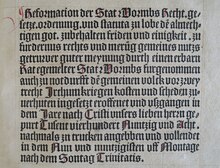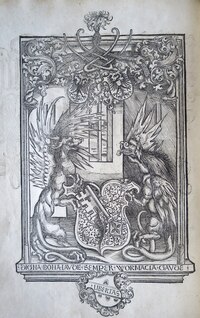Worms Reformation

|

|
|
|
Title of the edition of 1499
|
Imprint of the edition of 1499
|

|

|
|
|
Frontispiece of the edition of 1499
|
Representation of the relationships in the edition of 1499
|

|

|
|
|
Book 6, Part 2: Inquisition Trial in Criminal Matters in the 1499 edition
|
Book 6, Part 2: Inquisition Trial in Criminal Matters in the 1542 edition
|
The Worms Reformation (original title: Der Statt Wormbs Reformation ) was a summary of the law applicable in the city of Worms and was published in 1499.
Emergence
Due to the destruction of Worms in 1689 in the Palatinate War of Succession by the troops of King Louis XIV, there are only a few sources on municipal law from the time before the Worms Reformation .
The Worms Reformation was created in 1498. Traditional writings that contained imperial law were also used as sources. The Nuremberg Reformation of 1479, first printed in 1484, served as a model . Nothing is known about the editing process or the specific occasion. Circumstances that promoted the work on the work were an atmosphere in the leading circles of Worms turned towards humanism , the presence of numerous lawyers in the city due to the fact that the Imperial Court of Justice had its seat here from 1497 to 1499, the wish of the city itself towards his bishop , Johann XX. von Dalberg , to be demarcated and made independent, and also that Worms was exposed to competitive pressure with other imperial cities within the empire to have a “modern” law as a locational advantage . The Worms Reformation is a collection of laws typical of the period of reception .
The Worms Reformation was officially published on August 15, 1499 in a meeting of guild masters and a hundred other guild members convened by the city council, and it was printed in the same year.
It is one of the earliest and one of the most extensive municipal law collections of the time.
content
In principle, the Worms Reformation wanted to preserve traditional law. However, the editing was done by lawyers who had studied Roman law . The result of this editing process was that the Worms Reformation hardly contained any original Worms city law, but largely Roman law. Conversely, the city of Worms derived from this that its collection of laws was generally valid, i.e. could also claim validity beyond Worms. However, one party in civil proceedings was still allowed to invoke Worms customary law , for the validity of which they then bore the burden of proof .
Procedural and judicial constitutional law outweigh the provisions on substantive law .
Validity
The Worms Reformation also owed its spread and rapid implementation to the new medium of letterpress printing . The first edition appeared in print as early as 1499.
The practical significance of the Worms Reformation can also be seen in the additions and improvements that were documented in the later editions. The legal collection remained binding as municipal law until the beginning of the 19th century: In the course of the French Revolution, the areas on the left bank of the Rhine were under French administration from 1797/98 and also formally became part of France with the Peace of Lunéville in 1801 . From March 21, 1804, the Civil Code was binding for civil law in Worms and, from 1810, the Code pénal for criminal law .
structure
In a preface justice is first praised, the benefits of written laws highlighted and emphasized that the Worms City Council reserves the right to issue additional legal provisions in the event of doubts about the interpretation or cases that the Worms Reformation has not yet covered. The Worms Reformation is divided into six books:
- First instance trial before the city court
- Appeal procedure before the city council
- Lawsuit , defense , evidence
- Substantive private law (1)
- Substantive private law (2)
- Criminal law , criminal process , embarrassing questioning
effect
Due to the clear structure and the comprehensive content, the Worms Reformation affected numerous subsequent legal collections of the 16th century. These included the Württemberg Land Law and the Jülich Reformation (both: 1555), the Reformation of the Electoral Palatinate in 1582, the Reformation of Basel in 1610 and the Baden Land Law of 1622.
literature
expenditure
- 1499 - 1st edition. This first edition was printed by Peter Drach in Speyer until May 27, 1499 on 173 counted and 13 counted sheets in folio format .
- 1507 - 2nd edition. 94 counted, 6 uncounted sheets in folio. Peter Drach, Speyer.
- 1513 - 3rd edition. 94 counted, 6 uncounted sheets in folio. Peter Drach, Speyer.
- 1531 - 4th edition. 80 numbered, 6 unnumbered sheets, Christian Egenolph , Frankfurt am Main .
- 1534 - 5th edition. 12 numbered, 173 unnumbered folio sheets. Frankfurt am Main
- 1542 - 6th edition. 12 numbered, 173 unnumbered folio sheets. Gregorius Hofmann , Worms. This is the only edition that contains amendments to a large extent, as well as a document from Emperor Maximilian I from 1505, in which he expressly recognized the old freedoms of the city and especially the reformation of the Stat Wormbs rights, order, policey, justice, good habits and old origins confirmed.
- 1561 - 7th edition. 165 unnumbered and 14 numbered folio sheets. Worms.
- 1564 - 9th edition. 165 unnumbered and 14 numbered folio sheets. Worms.
- 1985 Gerhard Köbler (ed.): Der Statt Wormbs Reformation . 1st edition. Giessen 1985. ISBN 978-3-88430-048-0
- 2008 Daniela Simbeni (editor), Gerhard Köbler (ed.): Der Statt Wormbs Reformation . Giessen 2008. [Exclusively digital, see: Weblinks]
Secondary literature
- Friedrich Battenberg : Worms Reformation . In: Adalbert Erler among other things: Concise dictionary on German legal history Volume 5. 1st edition. Erich Schmidt Verlag, Berlin 1998. ISBN 978-3-503-00015-9 , Sp. 1536f.
- Hans Diehl: Court constitution and civil litigation in the Worms Reformation from 1499 = dissertation Freiburg. Eugen Kranzbühler. Worms 1932.
- Gerhard Köbler: Der Statt Wormbs Reformation = work on law and linguistics 27. Giessen 1985. ISBN 3-88430-048-2 [contains a scaled-down reproduction of the edition from 1499]
Web links
- Gerhard Köbler: Reformation der Statt Wormbs (2008). Contains the digitized text; accessed on February 7, 2020.
Remarks
- ↑ Other well-known legal collections of the time are for example the Nuremberg Reformation (1479/1484), the Bambergische Peinliche Halsgerichtsordnung (1507), the Freiburg City Law (1520), the Württemberg Land Law and the Jülich Reformation (both: 1555), the General Articles of Electoral Saxony (1557 ) and the Solms land law (1570).
- ^ Additional information from Köbler: Reformation der Statt Wormbs : " Philip Köpfel for Weygand Han in Frankfurt".
Individual evidence
- ↑ Köbler: Der Statt Wormbs Reformation (1985), p. XVIIf. There is a paper volume with records on the municipal law of Worms from the 15th century in the Heidelberg University Library ( Codex patatinus germ. 163); others mentioned in Diehl, p. 7.
- ↑ Battenberg, Sp. 1536.
- ↑ Battenberg, Sp. 1537.
- ↑ Battenberg, Sp. 1536.
- ^ Köbler: Der Statt Wormbs Reformation (1985), p. XX.
- ^ Köbler: Der Statt Wormbs Reformation (1985), p. XXI.
- ↑ Köbler: Der Statt Wormbs Reformation (1985), p. XXIf.
- ^ Köbler: Reformation der Statt Wormbs (web links).
- ^ "Imprint" of the 1499 edition.
- ↑ Battenberg, Sp. 1536.
- ↑ Battenberg, Sp. 1537.
- ↑ Diehl, p. 9.
- ^ Köbler: Der Statt Wormbs Reformation (1985), p. XII.
- ^ Köbler: Der Statt Wormbs Reformation (1985), p. XX.
- ^ Köbler: Der Statt Wormbs Reformation (1985), p. XXVI.
- ↑ This and the following information - unless otherwise noted - from: Köbler: Reformation der Statt Wormbs (web links).

